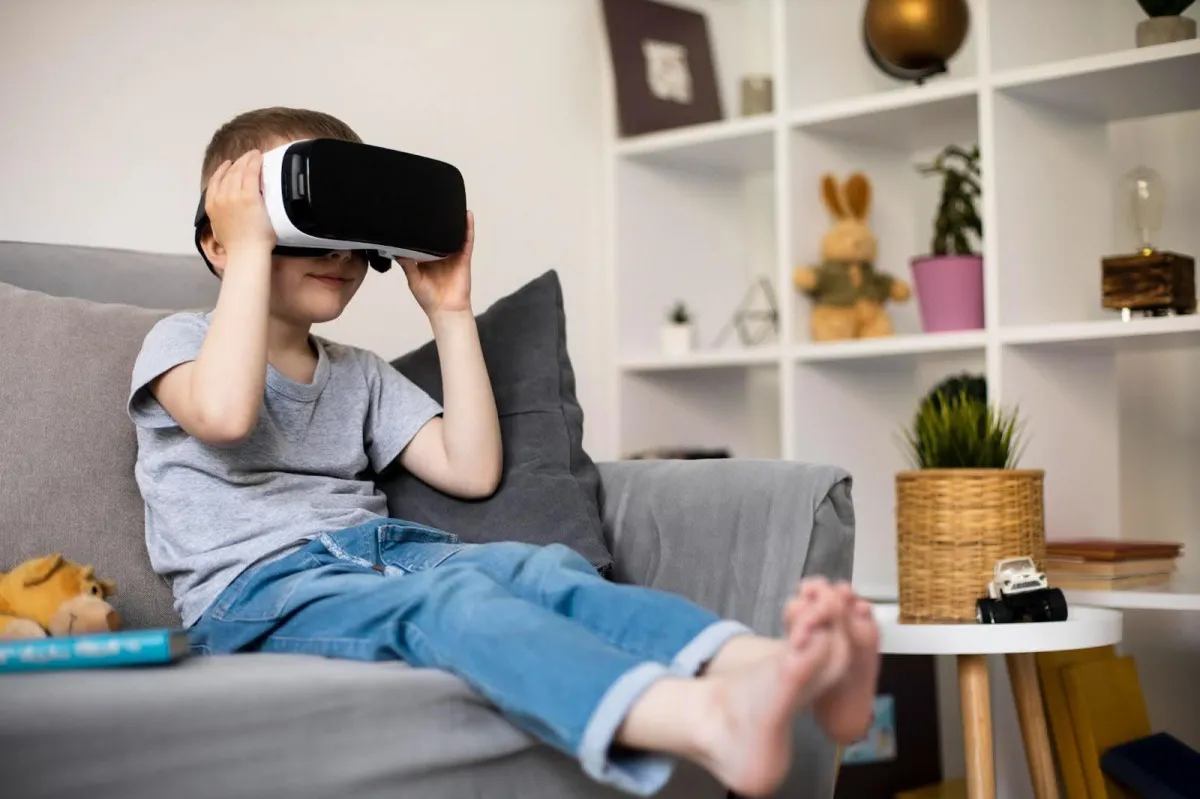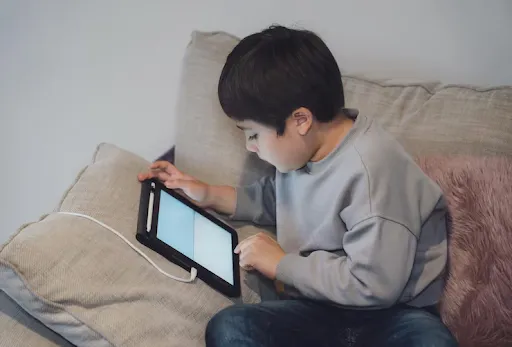Eye Health
How VR Impacts Children's Vision Development
FSDAVCFEBFEVSDDVFSD
FSDAVCFEBFEVSDDVFSD
FSDAVCFEBFEVSDDVFSD
Understanding VR's Visual Effects
Virtual reality (VR) offers immersive experiences, but its impact on children's vision is a growing concern. Prolonged VR use can lead to digital eye strain, characterized by symptoms like dry eyes, headaches, and blurred vision. Children may blink less while engaged in VR, leading to discomfort and fatigue.
Moreover, excessive screen time, including VR, has been linked to myopia progression in children. Studies indicate that each additional hour of screen time per day increases the risk of developing myopia by 21% . The lack of outdoor activities and natural light exposure further exacerbates this issue, as natural light plays a protective role against myopia development .
Virtual reality (VR) offers immersive experiences, but its impact on children's vision is a growing concern. Prolonged VR use can lead to digital eye strain, characterized by symptoms like dry eyes, headaches, and blurred vision. Children may blink less while engaged in VR, leading to discomfort and fatigue.

Moreover, excessive screen time, including VR, has been linked to myopia progression in children. Studies indicate that each additional hour of screen time per day increases the risk of developing myopia by 21% . The lack of outdoor activities and natural light exposure further exacerbates this issue, as natural light plays a protective role against myopia development .

Research on VR and Eye Development
Recent research highlights the relationship between virtual reality (VR) usage and children’s eye health. According to the American Academy of Ophthalmology, while VR headsets are not inherently harmful, prolonged use can lead to eye strain and fatigue. For children with pre-existing vision conditions, such as amblyopia or strabismus, discomfort may intensify during extended VR sessions, emphasizing the need for moderation in usage.
A meta-analysis published in JAMA Network Open reveals a significant association between increased daily screen time and a higher risk of developing myopia. This finding underscores the importance of monitoring and limiting children’s screen exposure, including time spent on VR devices. The study serves as a reminder that balancing technology use with other activities is crucial for maintaining long-term visual health, especially for young, developing eyes.
Additionally, the COVID-19 pandemic has significantly increased screen time among children, coinciding with a rise in myopia cases. This trend reinforces the importance of incorporating outdoor activities into children’s routines, as exposure to natural light plays a key role in healthy eye development. Parents and caregivers should encourage regular breaks from screens and ensure a mix of activities to support both physical and visual well-being.
Symptoms of VR-Induced Eye Strain

Children may display several symptoms of VR-induced eye strain, which parents should monitor closely. Common signs include dry or irritated eyes, often caused by reduced blinking during VR sessions. Prolonged focus on VR screens can also trigger tension headaches, while difficulty refocusing after VR use may result in temporary blurred or double vision. Additionally, extended VR sessions can overwork the eye muscles, leading to general eye fatigue and discomfort.
Recognizing these symptoms early is vital to prevent long-term effects.

If your child frequently experiences these issues after VR use, it’s a signal to reassess their screen habits. Limiting VR sessions, encouraging regular breaks, and promoting a balanced mix of activities can help alleviate strain. Consulting an eye care professional for persistent or severe symptoms is essential to ensure your child’s eye health is protected.
To mitigate the symptoms of VR-induced eye strain, it is essential to encourage regular breaks during VR sessions. Following the 20-20-20 rule can be particularly helpful: every 20 minutes, have your child look at something 20 feet away for at least 20 seconds. This practice allows the eye muscles to relax and reduces the risk of fatigue. Additionally, limiting the overall duration of VR use to age-appropriate timeframes can prevent excessive strain on young, developing eyes.
Proper headset fit and screen settings also play a crucial role in minimizing discomfort. Ensure the VR headset fits securely without being too tight, as an improper fit can strain the eyes and head. Adjusting screen settings, such as brightness, contrast, and focus, to comfortable levels can further reduce the risk of dry eyes and headaches. Parents should also supervise VR usage to monitor for any signs of discomfort and address them promptly. By combining these strategies, you can help your child enjoy VR experiences safely while protecting their visual health.
Safe VR Practices for Children
Implementing safe VR practices is essential for protecting your child’s vision. Start by limiting VR usage to short sessions, ensuring ample breaks between to rest the eyes and reduce fatigue. Using VR in a well-lit environment can also minimize strain by balancing screen brightness with ambient light. Properly adjusting the headset settings, such as interpupillary distance and brightness, is crucial for creating a comfortable experience and preventing unnecessary eye discomfort. Additionally, encourage children to blink regularly during VR use to maintain eye moisture and prevent dryness.
Beyond managing VR usage, balancing screen time with outdoor activities is equally important. Time spent outdoors exposes children to natural light, which is vital for healthy eye development and reducing the risk of myopia. Engaging in activities like sports, walks, or playtime not only supports overall well-being but also serves as a counterbalance to prolonged screen exposure. By combining these strategies, you can help safeguard your child’s vision while allowing them to enjoy VR responsibly.
Importance of Regular Eye Exams
Regular eye examinations are crucial for early detection and management of vision issues in children. Pediatric eye exams can identify conditions like myopia, enabling timely interventions to prevent complications. These assessments are particularly important for children frequently using screens or VR devices, as they face a higher risk of vision-related problems.
Scheduling comprehensive eye exams ensures any changes in your child’s vision are closely monitored.
Regular eye examinations are crucial for early detection and management of vision issues in children. Pediatric eye exams can identify conditions like myopia, enabling timely interventions to prevent complications. These assessments are particularly important for children frequently using screens or VR devices, as they face a higher risk of vision-related problems.
Scheduling comprehensive eye exams ensures any changes in your child’s vision are closely monitored. Early detection allows for effective treatment plans to slow the progression of vision issues and maintain overall eye health. Regular check-ups also provide guidance on managing screen time and reducing eye strain, supporting healthy visual development.

By prioritizing routine eye exams , you take a proactive approach to protecting your child’s vision. This helps address existing concerns and promotes long-term eye health, enabling your child to enjoy a balanced and healthy lifestyle.

Early detection allows for effective treatment plans to slow the progression of vision issues and maintain overall eye health. Regular check-ups also provide guidance on managing screen time and reducing eye strain, supporting healthy visual development.
By prioritizing routine eye exams, you take a proactive approach to protecting your child’s vision. This helps address existing concerns and promotes long-term eye health, enabling your child to enjoy a balanced and healthy lifestyle.
Tips for Parents to Protect Children's Vision
Parents play a vital role in safeguarding their children's eye health, especially in today’s digital age. One effective strategy is implementing the 20-20-20 rule, which helps reduce eye strain caused by prolonged screen use. Encourage your child to take a break every 20 minutes to look at something 20 feet away for at least 20 seconds. This simple habit allows the eyes to relax and prevents overexertion of the eye muscles during extended VR or screen sessions.
Creating screen-free zones in your home can also help strike a healthy balance. Designate areas where screens are not allowed, such as dining areas or bedrooms. These zones promote family interaction, reduce screen dependency, and ensure your child’s eyes get much-needed breaks from digital devices, fostering a more mindful approach to technology use.
Encouraging outdoor play is another essential practice to promote healthy vision. Aim for at least two hours of outdoor activities daily, as exposure to natural light supports proper eye development and reduces the risk of myopia. Whether it’s playing sports, taking a walk, or simply enjoying time outside, these activities provide a necessary counterbalance to screen-heavy routines.
Finally, monitoring and setting consistent limits on daily screen usage is crucial. Establish clear guidelines on how much time your child can spend on screens, including VR devices, and stick to these boundaries. By fostering these healthy habits, parents can actively support their child’s visual health while navigating the challenges of a technology-driven world. Taking these proactive steps ensures that your child can enjoy digital experiences responsibly without compromising their long-term eye health.
Recognizing Early Signs of Vision Issues
Parents play a crucial role in protecting their children's eye health in today’s digital age. A simple yet effective strategy is the 20-20-20 rule: every 20 minutes, have your child look at something 20 feet away for at least 20 seconds. This habit helps relax the eye muscles and reduces strain caused by prolonged screen use, including VR sessions.

Parents play a crucial role in protecting their children's eye health in today’s digital age. A simple yet effective strategy is the 20-20-20 rule: every 20 minutes, have your child look at something 20 feet away for at least 20 seconds. This habit helps relax the eye muscles and reduces strain caused by prolonged screen use, including VR sessions.
Creating screen-free zones at home fosters a healthy balance between technology and other activities. Designate areas such as dining rooms or bedrooms where screens are off-limits. These zones encourage family interaction, reduce screen dependency, and give children’s eyes much-needed breaks from digital devices.
Creating screen-free zones at home fosters a healthy balance between technology and other activities. Designate areas such as dining rooms or bedrooms where screens are off-limits. These zones encourage family interaction, reduce screen dependency, and give children’s eyes much-needed breaks from digital devices.
Encouraging outdoor play and setting limits on screen time are equally important. Aim for at least two hours of outdoor activities daily to promote eye development and reduce the risk of myopia. By combining these practices, parents can support their child’s visual health while ensuring responsible screen use.
Conclusion: Balancing Technology and Eye Health
While VR provides immersive and engaging experiences, balancing technology use with practices that support eye health is essential. Prolonged screen exposure can strain young eyes, making it crucial for parents to set clear boundaries on VR sessions and overall screen time. Encouraging regular breaks, such as following the 20-20-20 rule, helps relax the eyes and prevent fatigue. Additionally, ensuring proper VR headset fit and adjusting screen settings for comfort can further reduce the risk of eye strain.
Routine eye exams are a vital component of maintaining children’s eye health. These check-ups allow for early detection of vision issues, ensuring timely intervention and effective management. Parents can also promote outdoor play to counterbalance screen time, as natural light supports healthy eye development and reduces the risk of myopia. By integrating these proactive measures, parents can help protect their children’s vision while allowing them to safely enjoy the benefits of digital technology.

Contact Info
Hours of Operation
Mon - Fri | 9:00 AM - 5:00 PM
Sat - Sun | Closed
Holiday Hours: We are closed for the following holidays: New Years Day, Memorial Day, Independence Day, Labor Day, Thanksgiving Day, Christmas Day
© 2025 Kleinwood Vision. All rights Reserved.


